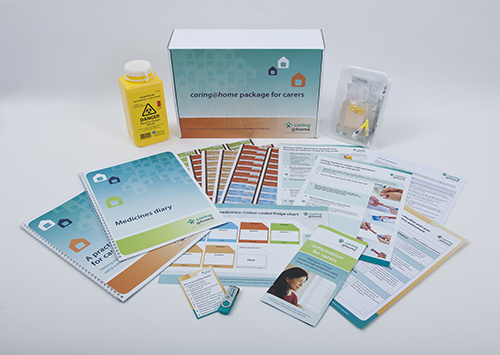If you're a patient or carer, please talk to your GP or visit Palliative Care Australia for more information.
Health professionals
Learn more about our caring@home package for carers and how to get started.
Using the Standard caring@home resources package

The Standard caring@home resources package is a free downloadable set of resources for health professionals to use with families and carers.
You can print or download individual resources from the list below.
Clinical services can reproduce resources:
- Assembly guide: practice demonstration kit
- How to print syringe labels
- How to print the Standard caring@home Package for Carers box label
Resources
| We recommend printing resources in colour for families. | ||
|---|---|---|
| Managing subcutaneous medicines - see all resources for carers and families | ||
| Health professionals can use the information brochure to introduce carers to how they can help manage breakthrough symptoms safely using subcutaneous medicines. | Information for carers: Helping to manage symptoms with medicines at home | |
| The handbook provides written and pictorial material with all the information a carer needs to help manage breakthrough symptoms safely using subcutaneous medicines. | Practical handbook for carers | |
| The medicines diary is for a carer to record all the subcutaneous medicines that are given. | Medicines diary | |
| The Fridge chart acts as an extra safety check to ensure the correct medicine is given for each breakthrough symptom. | Fridge chart | |
| The syringe labels are pre-printed and colour-coded for eight (8) commonly-used palliative care symptom management medicines. | Syringe labels | |
| The illustrated guides and videos explain how to manage subcutaneous medicines safely in the home using a step-by-step approach. | Writing a label, opening an ampoule and drawing up medicine: A step-by-step guide | |
| Giving medicine using a subcutaneous cannula | ||
| See all training videos for carers | Video 1 - caring@home Introduction | |
| Video 2 - Recognising and rating breakthrough symptoms | ||
| Video 3 - Subcutaneous medicines | ||
| Video 4 - Writing a label, opening an ampoule and drawing up medicine | ||
| Video 5 - Giving medicine using a subcutaneous cannula | ||
| Video - Ampoule opening technique | ||
| The training checklist is used to guide the one-on-one training with a carer, and to check carer competency after the training sessions. | Training checklist and carer/family post-training competency assessment | |
Using the caring@home resources
To learn more about how to use the caring@home resources, read our frequently asked questions.
